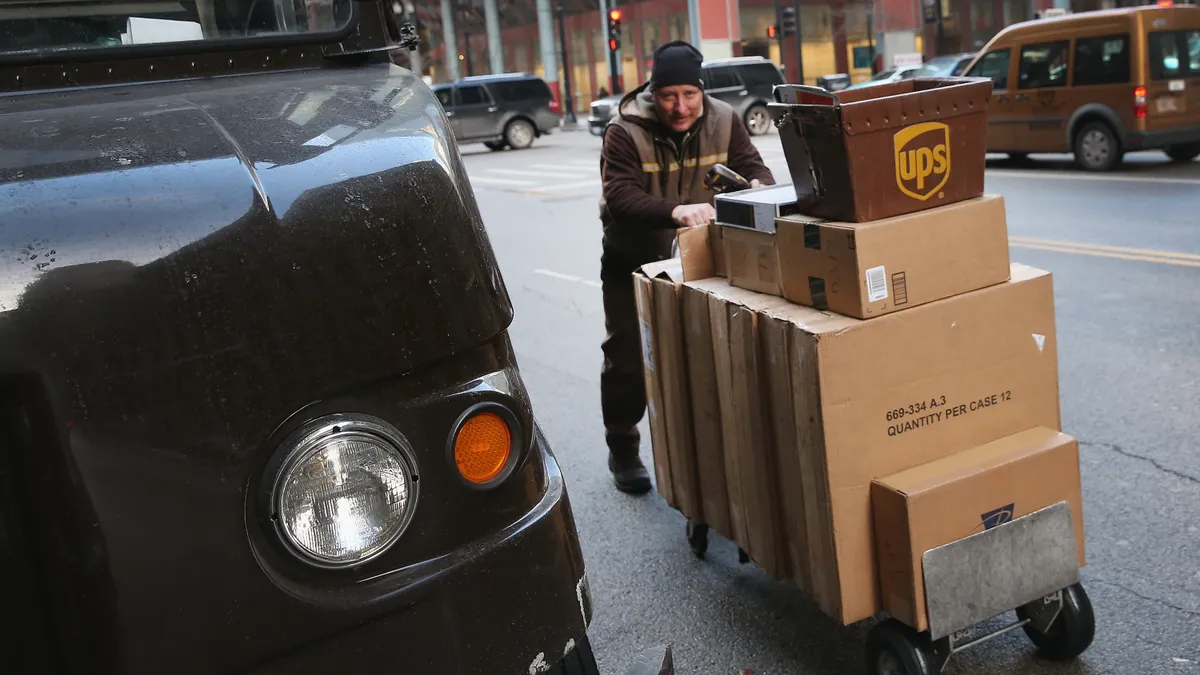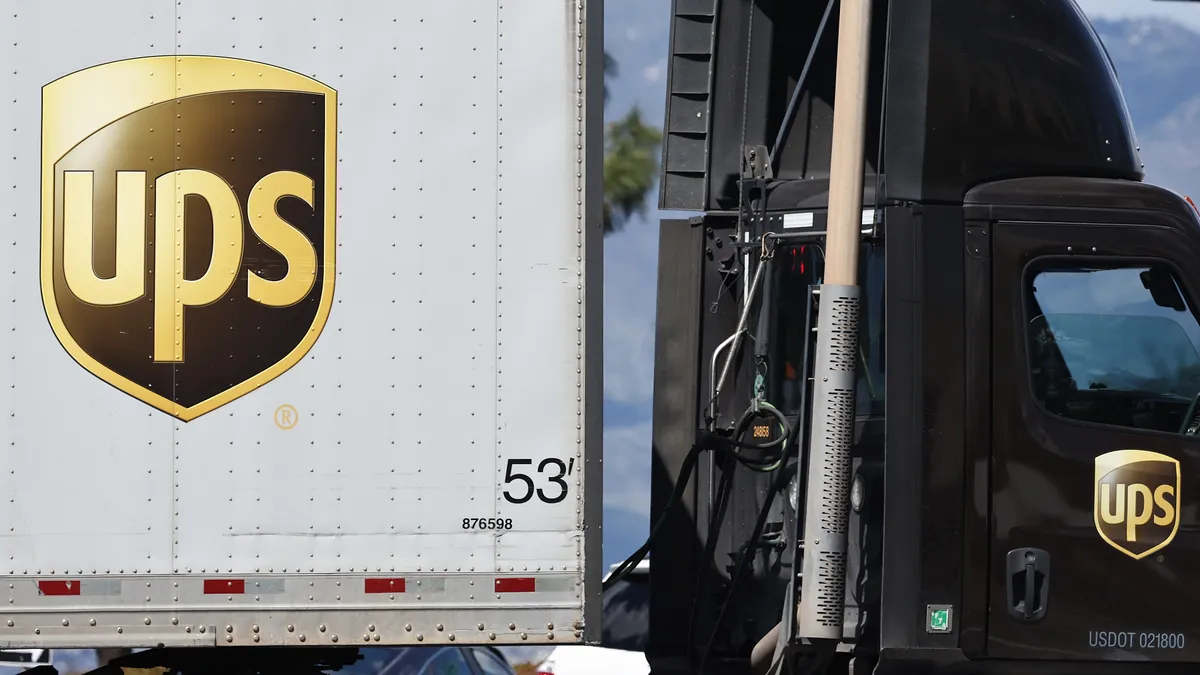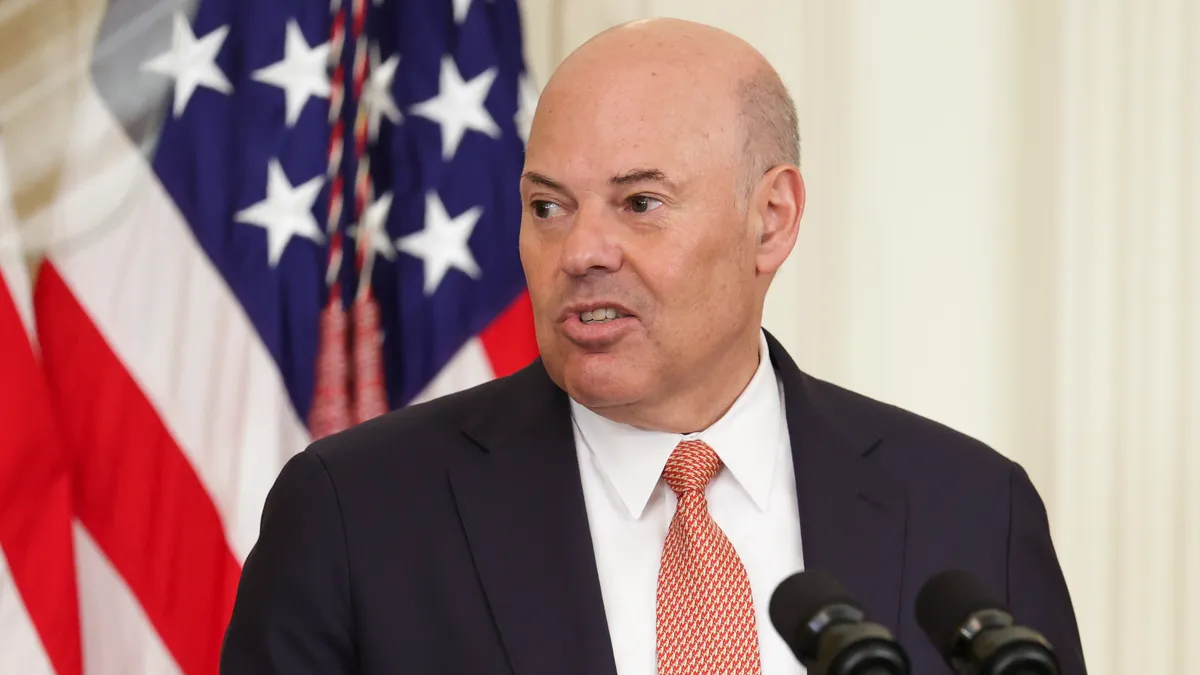Even before UPS announced it would slash 12,000 jobs this year, the delivery giant's efforts to reduce its employee count were well underway.
UPS had 543,000 employees at the end of 2020 when the COVID-19 pandemic led to a swell of home deliveries that spurred parcel carriers to ramp up hiring. The pandemic bump didn't last for long, however, with package volume slumping in recent quarters.
In response to softer demand, UPS has trimmed its employee count at both the frontline and management levels. At 2023's end, the company employed 500,000 people, a nearly 8% reduction from its pandemic-driven highs.
UPS employs fewer managers, hourly employees after COVID-19 boom
CEO Carol Tomé said in a January earnings call that two of the company's top executives — EVP and U.S. President Nando Cesarone and Kate Gutmann, EVP and president of UPS' International, Healthcare and Supply Chain Solutions segments — "have done a masterful job of managing our operational headcount to meet the volume in our company." Measures taken by the two executives include closing sortation shifts and reducing block hours in its air cargo network.
UPS has also tapped into AI and machine learning advancements to shift volume from more labor-intensive package sorting facilities to automated hubs. The company reduced its labor hours by nearly 10% with this approach when customers leaned more on other carriers during its contract negotiations with the International Brotherhood of Teamsters.
Now, more layoffs are on the horizon. Headcount reductions in 2024 will be concentrated within management roles and contracted positions, with 75% of the cuts coming in the first half of 2024, executives said. UPS will see a $1 billion benefit this year from the reductions.
"What we're seeing at a macro level is demand across the entire industry is down," said Abe Eshkenazi, CEO of the Association for Supply Chain Management. "I think they're responding to the demand signals that are in the marketplace right now."
UPS' distinct challenges
UPS isn't the only parcel carrier laying off employees in a tepid demand environment. Rival FedEx reduced its U.S. headcount by about 29,000 employees in fiscal year 2023, CEO Raj Subramaniam said in June. The move came a few months after FedEx announced it would cut more than 10% of its officer and director staff.
Still, industry experts told Supply Chain Dive that UPS is dealing with distinct challenges that could be further motivating its aggressive headcount reductions.
Jeremy Tancredi, a partner in West Monroe’s Operations Excellence practice and a former UPS industrial engineer, said UPS historically has made management-level cuts to tame costs after inking new union contracts. The latest round of cuts comes after the August ratification of a new contract that features higher wages for Teamsters-represented U.S. employees.
Tancredi said UPS made cuts in its industrial engineering department following the 1997 Teamsters strike, for example, but then tried to hire many affected employees back a few years later.
"They always felt that it's easier to cut and add back," Tancredi said of UPS.
Alan Amling, an assistant professor of practice at the University of Tennessee and former VP of corporate strategy for UPS, has a different take. He said UPS' planned reductions stem more so from decisions leadership made amid an unprecedented period — demand was surging and carrier capacity was tight during the pandemic. That put upward pressure on delivery rates, bolstering UPS' bottom line.
During that yearslong stretch, UPS prioritized winning more profitable volumes through Tomé's "better, not bigger" framework while deemphasizing lower-margin shipments like home deliveries for e-commerce orders. Amling added that the company also sharply increased its dividend payouts to shareholders and continues to do so, despite revenue falling more than 9% in 2023.
"This could use a 'Three Little Pigs' analogy," Amling said. "You had a house with brick, and you said, 'We can build a house of sticks and outsource the construction of the house, and it'll be just as good,' then you blame it on the big bad wolf when he blows your house down."
How will UPS adjust?
Industry observers are split on what areas within UPS will see an impact from the upcoming headcount reductions.
Since the cuts are focused on the management ranks, the company could restructure or combine operating regions like it has in the past to usher this process along, according to Tancredi. Impacted employees may seek jobs at rival companies such as FedEx, which is in the midst of creating an integrated air-ground network like UPS already has.
"They're going to get people that know how an integrated network looks, so you're going to lose people to your biggest competitor," Tancredi said.
Dean Maciuba, managing partner, United States, for Crossroads Parcel Consulting, said automating the pricing process for small and medium-sized business customers could help UPS reduce its employee base on the sales side. In the earnings call, Tomé highlighted how the company's new Deal Manager tool can close sales deals quicker by relying on AI and machine learning for pricing quotes, helping the company's efforts to capture more market share.
"We've had great acceptance and win rates, 79% win rates with this tool," Tomé said.
No matter what approach UPS takes to its headcount reductions, experts agree that UPS will maintain a strong focus on bolstering its profitability despite withering demand and other challenges. The path to profit growth looks much different in a soft parcel market than a surging one, however, and involves a lot fewer employees.
"I think they're really hell-bent on getting their pricing in line with their costs, and I don't think it matters how many people they decide they have to lay off to get to that point," Maciuba said.






















